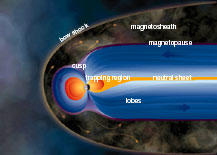Artist conception of the CAPER trajectory
Click on image for full size
Image courtesy of NASA/Marshall
Scientists Successfully Launch CAPER
News story originally written on January 23, 1999
After having to wait weeks for the right solar and atmospheric conditions,
scientists were finally able to launch CAPER--the Cleft Acceleration
Plasma Experimental Rocket. It was launched from the Andoya Rocket Range
in Norway.
CAPER will help scientists find out what causes low energy particles to
leave the Earth's atmosphere. They think that
electrical instabilities in the
ionosphere give ions the
energy they need to break away into the
magnetosphere.
You might also be interested in:

The Earth has a magnetic field with north and south poles. The Earth's magnetic field reaches 36,000 miles into space. The magnetic field of the Earth is surrounded in a region called the magnetosphere.
...more
It was another exciting and frustrating year for the space science program. It seemed that every step forward led to one backwards. Either way, NASA led the way to a great century of discovery. Unfortunately,
...more
The Space Shuttle Discovery lifted off from Kennedy Space Center on October 29th at 2:19 p.m. EST. The weather was great as Discovery took 8 1/2 minutes to reach orbit. This was the United States' 123rd
...more
A moon was discovered orbiting the asteroid, Eugenia. This is only the second time in history that a satellite has been seen circling an asteroid. A special mirror allowed scientists to find the moon
...more
Will Russia ever put the service module for the International Space Station in space? NASA officials want an answer from the Russian government. The necessary service module is currently waiting to be
...more
A coronal mass ejection (CME) happened on the Sun early last month. The material that was thrown out from this explosion passed the ACE spacecraft. The SWICS instrument on ACE has produced a new and very
...more
J.S. Maini of the Canadian Forest Service called forests the "heart and lungs of the world." This is because forests filter air and water pollution, absorb carbon dioxide, release oxygen, and maintain
...more









